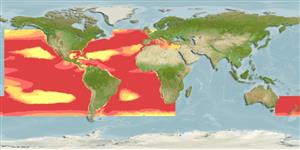Environment: milieu / climate zone / depth range / distribution range
Ecology
Marine; bathypelagic. Deep-water; 55°N - 49°S, 180°W - 180°E
Probably worldwide in tropical and subtropical seas. Eastern Atlantic: southern Ireland, scattered records in western Mediterranean, also Madeira Islands. Western Atlantic: Gulf of Mexico (Ref. 27768). Western Pacific: Australia (Ref. 7300) and New Zealand (Ref. 5755).
Size / Weight / Age
Maturity: Lm ? range ? - ? cm
Max length : 21.0 cm TL male/unsexed; (Ref. 3978)
Mesopelagic species (Ref. 3978, 58302). Generally solitary. Probably feeds on zooplankton. Spawns throughout the year in the Mediterranean, more in winter.
Life cycle and mating behavior
Maturity | Reproduction | Spawning | Eggs | Fecundity | Larvae
Cohen, D.M., 1984. Argentinidae (including Microstomatidae). p. 386-391. In P.J.P. Whitehead, M.-L. Bauchot, J.-C. Hureau, J. Nielsen and E. Tortonese (eds.) Fishes of the north-eastern Atlantic and the Mediterranean, Volume 1. Unesco, Paris. (Ref. 4773)
IUCN Red List Status (Ref. 130435: Version 2024-1)
Threat to humans
Harmless
Human uses
Fisheries: of no interest
Tools
Special reports
Download XML
Internet sources
Estimates based on models
Preferred temperature (Ref.
123201): 8.8 - 19.6, mean 13.4 °C (based on 608 cells).
Phylogenetic diversity index (Ref.
82804): PD
50 = 1.0000 [Uniqueness, from 0.5 = low to 2.0 = high].
Bayesian length-weight: a=0.00389 (0.00180 - 0.00842), b=3.12 (2.94 - 3.30), in cm total length, based on all LWR estimates for this body shape (Ref.
93245).
Trophic level (Ref.
69278): 3.4 ±0.45 se; based on food items.
Fishing Vulnerability (Ref.
59153): Low vulnerability (11 of 100).
